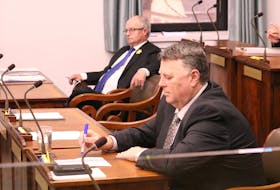The aging population is about to expose another problem: given the longevity of life expectancy, are Islanders financially prepared for retirement?
Most Canadians are on their own for retirements. In Canada, only 34 per cent of the workforce has employer-sponsored pensions (30 per cent in P.E.I.). The rest of Canadians must save for retirement or depend on the Canada Pension Plan (CPP) and/or Old Age Security (OAS). While CPP is healthy in terms of sustainability at current payouts, it’s only available to those who have contributed to the plan – and maxes out at $1,100 per month. Without other resources, those relying on CPP and/or OAS are facing a life of poverty or a significantly diminished standard of living.
As a rough rule of thumb, to maintain the same standard of living before retirement, an individual needs about 70 per cent of their pre-retirement income. If a household’s income leading up to retirement was $100,000 per year with two incomes, $70,000 is needed after retirement to maintain current standards.
The maximum payout per individual for CPP is $13,600. Using the example above, a two-income household with no other retirement savings would receive less than $30,000 from CPP and have a $40,000 shortfall to maintain previous standards of living.
Not everyone qualifies for CPP; in Canada, the current labour force participation rate (those available to work) among the working-age population is 66 per cent (68 per cent in P.E.I.) – and the number actually working is 63 per cent (same for the Island). This indicates about one-third of Islanders retiring are not eligible for CPP and must rely on other pensions, their own savings or OAS. The maximum OAS and Guaranteed Income Supplement (GIS) for those considered to be in poverty is about $13,800. This segment most at risk in terms of being able to enjoy their retirement at their previous standard.
Pensions are a divisive issue – an example of haves and have nots. As of 2018, 88 per cent of those who work in the public sector have pensions - and that percentage has been increasing since 2008. The majority of public sector pensions are defined benefits (91 per cent) or fully indexed pensions, guaranteeing payouts increase with inflation. These are the most expensive types of pensions and are only possible because it is taxpayer-funded. Defined benefit pensions have been declining recently and changing into defined contribution plans, which do not guarantee specific payout amounts, only define the contributions made to a pension. The performance of the pension fund determines what is available to be distributed. It’s like an RRSP, except instead of only the taxpayer making a contribution, the employer also contributes.
In the private sector, only the largest companies can afford pension plans. Few small- or medium-sized companies have the capacity to fund pension plans for employees - meaning only 25 per cent of those who work in the private sector have a pension. The percentage with a defined benefit (inflation protected) plan has decreased from 61 per cent to 40 per cent in the past 10 years. This underscores the increasing difficulty of non-taxpayer funded pensions to afford defined benefit plans.

The majority of taxpayers are helping fund generous public sector pension plans they do not have themselves. While I’m not advocating eliminating public sector pensions, I am suggesting Canada has a responsibility to ensure adequate retirement funds for those who do not have a pension. The public sector should also move to a defined contribution plan for all new hires to ensure long-term sustainability and fairness with the private sector.
The federal government must commit to substantially increasing CPP payouts by committing tax revenue to this purpose, the same way taxpayers help fund public sector pensions. This includes increasing the contributions by those working and from the federal government by allocating more taxpayer money for that purpose to the CPP and OAS. At minimum, the government should guarantee a retirement income at least above the poverty line in Canada - currently $20k for an individual and $28k for a couple in P.E.I., where 10 per cent of residents currently live below the poverty line, according to the latest census.
There has been considerable discussion about a need for guaranteed income for all Canadians. We should begin with a guarantee income for retired Canadians so they can fully enjoy their final years as they deserve.
Don Mills is the former owner of Corporate Research Associates and a recognized expert in data trends in Atlantic Canada. He can be contacted at [email protected] or on Twitter at @donmillshfx
RELATED:









